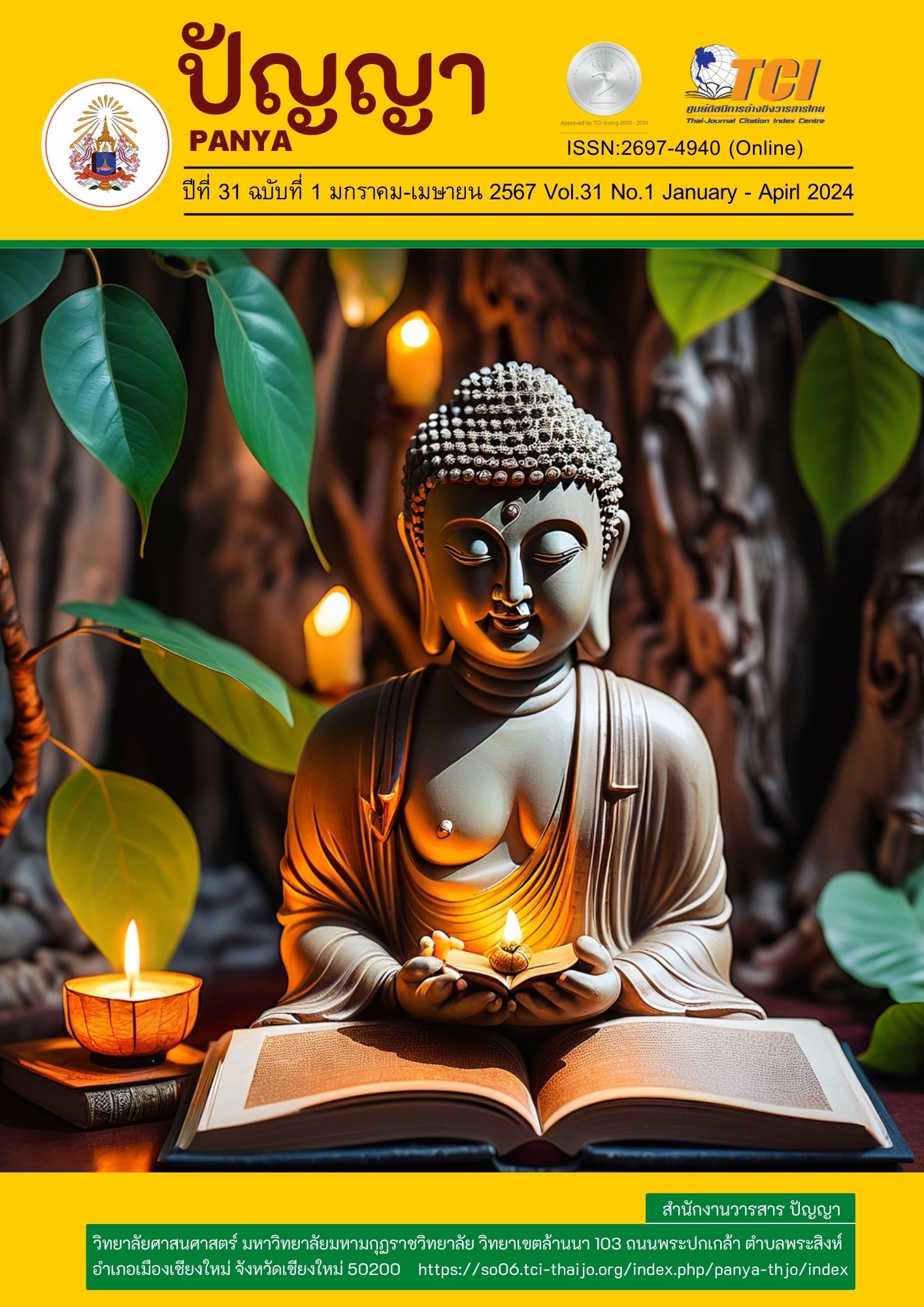Development of academic administration models To develop the creativity of teachers and child care workers, Sri Nakhon Ping Chiang Mai Teachers andChild Care Association, Mueang District, Chiang Mai Province
Keywords:
model development, academic administration, learning experience organization, creativityAbstract
The objectives of this article research were : 1) Study the academic administration conditions of the Sri Nakhon Ping Chiang Mai Teachers and Child Caregivers Association. 2) Create a model for academic administration in organizing learning experiences. To develop the creativity of teachers and child caretakers. 3) Experiment with academic administration models for organizing learning experiences. To develop the creativity of teachers and child caretakers. 4) Evaluate the academic administration model in organizing learning experiences. To develop the creativity of teachers and child caretakers
The research results found that:
1. Condition of academic administration of the association from the analysis of necessary needs The maximum analysis value is Organizing learning experiences Actual condition I= 33 Desired condition D=99 (I-D)/D= 0.667 shows that teachers and child caretakers Want to develop learning experience management to be of better quality
2. Create and verify the model 1) using project-based teaching. and teaching activities with design thinking. 2) Confirm the model with Delphi Technique. The results of the analysis of IQR = 0 for every item show that the experts have consensus opinions. and validated the model with CFA.
3. Take the model and test it in child development centers and kindergartens that are members of the association. 253 teachers and child caretakers designed learning management according to training. Teachers and child caretakers' creativity was tested in 14 areas using Jellen & Urban's creativity test.
4. Evaluate the model with LGM developmental curve statistics. It was found that after using the model for teachers and child caretakers There is a rate of development in creativity. They are significantly different at .01** all 14 items.
References
กรมวิชาการ. (2546ก). คู่มือหลักสูตรการศึกษาปฐมวัย พุทธศักราช 2546. โรงพิมพ์คุรุสภา.
ชนาธิป บุบผามาศ. (2565). การศึกษาข้อมูลพื้นฐานและการพัฒนารูปแบบการสอนตามแนวคิดเชิงออกแบบเพื่อส่งเสริมความสามารถในการออกแบบการจัดประสบการณ์โดยใช้กิจกรรมเป็นฐานของนักศึกษาครู. วารสารวิชาการมหาวิทยาลัยราชภัฏเพชรบุรี, 12(1), 117-125. https://so03.tci-thaijo.org/index.php/ajpbru/article/view/255875/173891
ชัชวีร์ แก้วมณี. (2564). การพัฒนารูปแบบชุมชนแห่งการเรียนรู้ทางวิชาชีพครูเพื่อเสริมสร้างสมรรถนะการจัดประสบการณ์การเรียนรู้ของครูปฐมวัยในศตวรรษที่ 21. วารสารมหาวิทยาลัยราชภัฏยะลา, 16(3), 397-405. https://so04.tci-thaijo.org/index.php/yru_human/article/view/251087/172579
น้ำผึ้ง มีศิล. (2559). การวิจัยด้วยเทคนิคเดลฟาย: การหลีกเลี่ยงมโนทัศน์ที่ไม่ถูกต้อง. วารสารสาขามนุษยศาสตร์สังคมศาสตร์และศิลปะ. 9(1), 1256-1267. https://he02.tci-thaijo.org/index.php/Veridian-E-Journal/article/view/61679/50809
เบญจวรรณ คำมา และ เหมมิญญ์ ธนปัทม์มีมณี. (2562). การพัฒนาการจัดประสบการณ์การเรียนรู้ประกอบสื่อประสม เพื่อพัฒนากล้ามเนื้อ มัดเล็กและความคิดสร้างสรรค์ สำหรับนักเรียนชั้นอนุบาลปีที่ 1. วารสารวิชาการการจัดการเทคโนโลยีสารสนเทศและนวัตกรรม คณะเทคโนโลยีสารสนเทศ มหาวิทยาลัยราชภัฏมหาสารคาม, 6(2), 154-162. https://ph02.tci-thaijo.org/index.php/itmjournal/article/view/203588/157518
พิมพ์พรรณ แก้วโต และ อธิพัชร์ วิจิตสถิตรัตน์. (2564). การพัฒนาชุดกิจกรรมศิลปะเพื่อพัฒนาความคิดสร้างสรรค์และทักษะทางศิลปะ ของนักเรียนชั้นมัธยมศึกษาปีที่ 6. [วิทยานิพนธ์การศึกษามหาบัณฑิต, มหาวิทยาลัยศรีนครินทรวิโรฒ]. DSpace at Srinakharinwirot University. http://ir-ithesis.swu.ac.th/dspace/bitstream/123456789/1958/1/gs611130384.pdf
พิศิษฐ ตัณฑวณิช และ พนา จินดาศรี. (2561). ความหมายที่แท้จริงของค่า IOC. วารสารการวัดผลการศึกษา มหาวิทยาลัยมหาสารคาม, 24 (2), 3–12.
ภาวิณี โตสำลี และ ณัฐทิญาภรณ์ การะเกตุ. (2564). การพัฒนาความคิดสร้างสรรค์ของเด็กปฐมวัย ชั้นอนุบาลปีที่ 3 ด้วยการจัดกิจกรรมศิลปะสร้างสรรค์. วารสารลวะศรี มหาวิทยาลัยราชภัฎเทพสตรี, 5(1), 53-66. https://so04.tci-thaijo.org/index.php/lawasrijo/article/view/250926/171453
วรรณภรณ์ มะลิรัตน์. (2562). การจัดประสบการณ์การเรียนรู้แบบเชิงรุก (Active Learning) โดยใช้ชุดกิจกรรมประกอบสื่อประสม เพื่อส่งเสริมการคิดวิเคราะห์ ของนักเรียนระดับชั้นอนุบาลปีที่ 3 โรงเรียนเทศบาลป้อมแผลงไฟฟ้า. วารสารเทคโนโลยีและสื่อสารการศึกษา มหาวิทยาลัยมหาสารคาม, 3(7), 177-186. https://so02.tci-thaijo.org/index.php/etcedumsujournal/article/view/242236/164430
สำนักงานเลขาธิการสภาการศึกษา. (2560). แผนการศึกษาแห่งชาติ พ.ศ. 2560-2579. พริกหวานกราฟฟิค.
สำนักงานเลขาธิการสภาการศึกษา. (2565). มาตรฐานการศึกษาชาติ พศ. 2562. บริษัท 21 เซ็นจูรี่จำกัด.
สุขุม มูลเมือง. (2559). เทคนิคการวิเคราะห์สถิติขั้นสูงโมเดลสมการโครงสร้างการประยุกต์ใช้โปรแกรม Amos และ Mplus. สำนักพิมพ์แห่งจุฬาลงกรณ์มหาวิทยาลัย.
สุวิมล ว่องวาณิช. (2550). การวิจัยประเมินความต้องการจำเป็น. สำนักพิมพ์แห่งจุฬาลงกรณ์มหาวิทยาลัย.
Cronbach, Lee J. (1951). Coefficient Alpha and The Internal Structure of Tests. Psychometrika,16(1951), 297-334. https://link.springer.com/article/10.1007/BF02310555
Faul, F., Erdfelder, E., Buchner, A., & Lang, A.-G. (2009). Statistical power analyses using G*Power 3.1: Tests for correlation and regression analyses. Behavior Research Methods, 41, 1149-1160. https://link.springer.com/article/10.3758/BRM.41.4.1149
Jellen, H.G. &Urban, K.K. (1989). Assessing Creative Potential World-wide: The First cross-cultural Application of the Test for Creative Thinking-drawing Production (TCT-DP). Gifted Education International, 6(2) , 78-55. https://www.deepdyve.com/lp/sage/assessing-creative-potential-world-wide-the-first-cross-cultural-NU0aFd73L1
Downloads
Published
How to Cite
Issue
Section
License
Copyright (c) 2024 Panya

This work is licensed under a Creative Commons Attribution-NonCommercial-NoDerivatives 4.0 International License.


